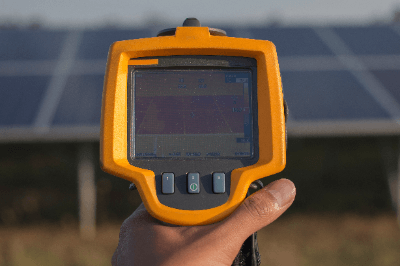What Is an Infrared Thermometer?
 An infrared thermometer is a device that detects the infrared radiation energy emitted from an object and displays an image of the temperature distribution on the object’s surface. Infrared thermography makes use of the property of infrared radiation that the higher the temperature of an object, the greater the amount of infrared radiation emitted.
An infrared thermometer is a device that detects the infrared radiation energy emitted from an object and displays an image of the temperature distribution on the object’s surface. Infrared thermography makes use of the property of infrared radiation that the higher the temperature of an object, the greater the amount of infrared radiation emitted.
Infrared thermometers can:
- Measure temperatures from a distance without touching the object
- Measure the temperature distribution over a wide area rather than at a single point on the object
- Measure temperatures in real time
This is a unique feature of the system.
Applications of Infrared Thermometers
Infrared thermometers are used in a variety of industries for temperature control, monitoring, and inspection due to their ability to provide real-time visualization of an object’s surface temperature.
On construction sites, it can detect invisible peeling of tiles on the exterior of a building by detecting differences in the surface temperature over time. It is also used for preventive maintenance of malfunctions, taking advantage of the fact that electrical equipment tends to reach high temperatures prior to failure.
Because temperatures can be measured hygienically without coming into contact with the object, the system is also used in the food industry to manage the storage conditions of fresh food, detect delivery leaks in prepared foods, and inspect packaging. In addition, because it can quickly visualize a person’s fever status in a non-contact manner, it is widely used as an admission thermometer for facilities that need to take countermeasures against infectious diseases.
Principle of Infrared Thermometers
Infrared thermometers detect the infrared energy emitted from the object being measured and convert this value into a temperature to determine the surface temperature of the object.
In addition to the infrared radiation energy from the object, the infrared thermography detector also receives (a) energy reflected by the object from the surrounding infrared radiation and (b) energy emitted by the infrared thermography itself, so the detected energy contains errors. Since (a) and (b) depend on the ambient temperature, which is measured at the same time as the incident energy, and after making corrections to eliminate the error factors (a) and (b), the infrared energy is converted to temperature.
Infrared energy is proportional to the fourth power of absolute temperature in the case of ideal thermal radiation emitted from a blackbody. In reality, the conversion from infrared energy to temperature is performed using a calibration table, since factors such as the emissivity of the object to be measured, the distance to the object, and the wavelength of the infrared radiation are also included.